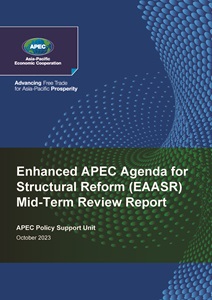
Proceedings
APEC Workshop on Promoting Decarbonization of Power Sector by Using Carbon-Free Energy (CFE)
The Asia-Pacific Economic Cooperation (APEC) is a regional economic forum established in 1989 to leverage the growing interdependence of the Asia-Pacific.
The Asia-Pacific Economic Cooperation (APEC) is a regional economic forum established in 1989 to leverage the growing interdependence of the Asia-Pacific.
APEC ensures that goods, services, investment and people move easily across borders. Members facilitate this trade through faster customs procedures at borders; more favorable business climates behind the border; and aligning regulations and standards across the region.
APEC ensures that goods, services, investment and people move easily across borders. Members facilitate this trade through faster customs procedures at borders; more favorable business climates behind the border; and aligning regulations and standards across the region.
APEC works to help all residents of the Asia-Pacific participate in the growing economy.
APEC works to help all residents of the Asia-Pacific participate in the growing economy.
Capacity building projects play an important role in helping translate APEC's goals into reality.
Capacity building projects play an important role in helping translate APEC's goals into reality.

Reports
•October 2023
Download Report
4MB
Published Under
Economic Committee (EC), APEC Secretariat, APEC Policy Support Unit
Accessed
2289
Pages
156
The Enhanced APEC Agenda for Structural Reform (EAASR) underscores APEC’s longstanding commitment to structural reforms. It also serves as the Economic Committee’s concrete, medium-term response to delivering on the APEC Putrajaya Vision 2040 and Aotearoa Plan of Action. The objective of this mid-term review report is to discuss progress, share experiences and lessons learned, and provide further guidance for reform actions by APEC member economies. In conducting the mid-term review of EAASR, the PSU has employed a two-pronged process: (1) at the APEC-wide level, through a set of endorsed external indicators and the EAASR Implementation Plan (which includes a short survey to gather member economies’ perceptions of EAASR implementation); and (2) at the individual economy level, using the individual action plans submitted by member economies.

